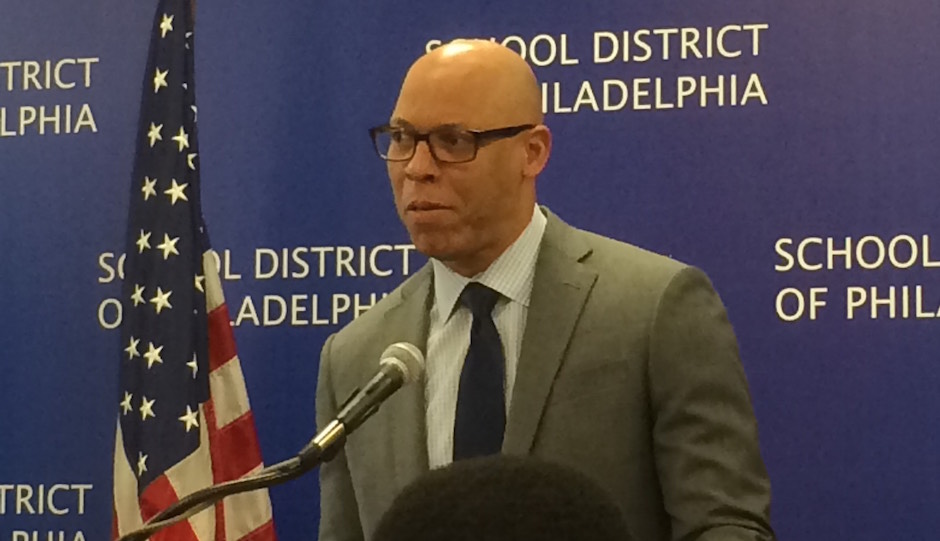3 Ways William Hite’s Action Plan 3.0 Could Revitalize Philadelphia Schools

Superintendent William Hite spoke to reporters while unveiling “Action Plan 3.0.”
After two years spent slashing programs, closing schools, and laying off thousands of workers, Philadelphia School Superintendent William Hite on Wednesday declared a victory of sorts.
The work of stabilizing the district is largely complete, he told reporters during a morning press conference — Philadelphia schools will end the fiscal year with a balanced budget. Now it’s time to turn to the work of actually improving schools and rebuilding public education in the city.
“We’ve spent the last two and a half years really stabilizing the district. … Now we can begin focusing,” Hite said as he unveiled “Action Plan 3.0,” a document that will guide the district as it begins to rebuild, covering everything from improving underperforming schools to better listening to parents to making classrooms safer to improving the process by which new charter schools are approved. (Action Plan. 1.0 focused on stabilizing the district; Action Plan 2.0 started to look forward. The plan unveiled Wednesday continues that trend. )
“We would’ve loved to do this three years ago,” Hite said. “But we couldn’t. We had to get to a place where we weren’t spending what we didn’t have.”
Even on a forward-looking basis, the plan speaks to the challenges of recent years. One brand-new item on the to-do list? “Provide teachers with the materials and supplies required to effectively teach students.” That simple — even fundamental — goal didn’t appear in previous editions of the plan.
The 56-page document (see the full thing below) offers two dozen action items, formulated after meeting with teacher, parent and student groups. Hite highlighted several goals.
• Starting in the 2016-17 school year, some individual schools will be given 100 percent autonomy. Under the arrangement, the district would give the school a per-pupil allocation for its budget, then let the school go on its merry way — operating much like a charter school — while turning district support services to schools more in need of help.
Hite said criteria for picking the autonomous schools hadn’t been decided yet, but he seemed to suggest that successful schools will be chosen for the program. “There are some schools that are doing very well, and we want them to continue to do very well,” he said, later adding: “The whole point of this is to allow those students to continue to do what they’re successful with.”
• The district will focus on “selective and purposeful” expansion of charter schools, doing more to hold existing charters accountable for their outcomes, and targeting new charters for areas of the city where the need — that is, the number of underperforming schools — is greatest. “Not just a bunch of new applications for Center City,” Hite said.
As for accountability, the plan says: “Starting this year, the majority of charter schools in Philadelphia will receive a School Progress Report, helping to facilitate apples-to-apples comparisons between schools serving similar populations and to identify promising practices that can and should be shared between sectors.” The idea? Start to discern whether charters really are better than their public school counterparts.
• The district will “reinvest” in “neighborhood networks” of local schools, trying to build strength at the hyperlocal level: Studies show proximity is a key factor in school selection, the report said.
The aim, Hite said, is equity: Every student deserves a chance to attend a decent school, even if they’re restricted to challenging neighborhoods. “We’re focusing on schools where students are there because they have no other choices,” Hite said.
One trend through the report: The increasing decentralization of district power over schools. Good schools will apparently get the chance to become autonomous; bad schools will be converted to charters, and other underperforming schools will be routed into “turnaround networks” where the schools remain under district control but are run by third-party operations.
“We no longer have the bandwidth to be all things,” Hite said, pointing out that district headquarters now has 400 staffers, where it once had 2,000. “It’s a recognition of the challenges we have. It’s also a recognition that any additional monies we get, they’ll go directly to schools. It’s a recognition that if other people can do those things better, we want to let them.”
See the full Action Plan 3.0 below.
Follow @JoelMMathis on Twitter.


